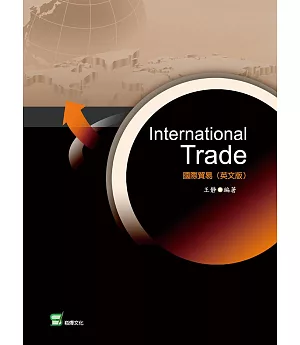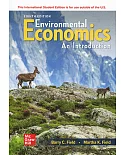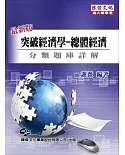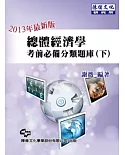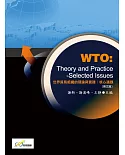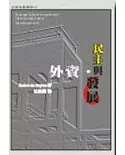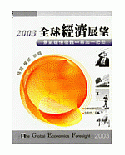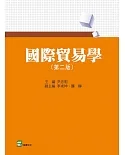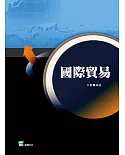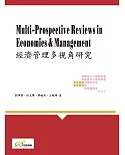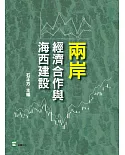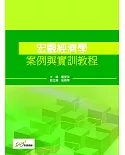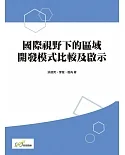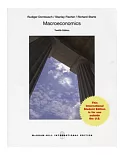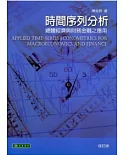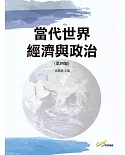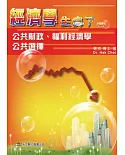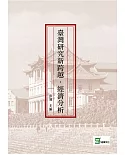本書為《國際貿易》英文版內容,由於西方國家在國際貿易理論研究領域起步較早,《國際貿易》所選經典國際貿易理論模型最初均為英文版本,譯文即便再力求精準,也難以完全避免因譯者的主觀理解和自身認知囿限而導致的偏誤,本著「認識一個事物最好是去認識其原本的樣子,而非別人認為的樣子」的理念,因此本書推薦給讀者結合《國際貿易》進行閱讀。
本書內容與《國際貿易》相同,第一章首先介紹世界經濟貿易發展的現狀和特點。接著從國際貿易理論和國際貿易政策兩個方面對國際貿易相關議題展開闡釋。國際貿易理論部分主要按照國際貿易發展的時間順序,介紹一系列經典的國際貿易理論模型。
第二章主要講解重商主義、絕對優勢理論和比較優勢理論等三個早期國際貿易模型,這些模型主要從生產的角度分析國際貿易產生的原因及可能的結果;第三章的主要內容是標準貿易模型,將消費納入到國際貿易分析中,從生產和消費的雙角度分析國際貿易現象;第四章介紹出口供給曲線、進口需求曲線、提供曲線和貿易條件,其中出口供給曲線和進口需求曲線主要用於某一商品的局部貿易均衡分析,而提供曲線為兩種商品的一般貿易均衡分析提供了便利,貿易條件概念的提出有助於分析貿易對一國或地區福利的影響;第五章的要素禀賦理論放鬆了對生產要素投入的限定,進一步揭示了國際貿易產生的根源;第六章將規模經濟和不完全競爭等現實因素考慮進來,分析了之前的貿易理論無法解釋的貿易現象;不同於之前各章主要在宏觀層面進行分析,第七章新新貿易理論從微觀視角分析國際貿易新現象和新特點;第八章經濟增長與國際貿易將分析從靜態轉變為動態,從發展的角度研究經濟各要素變化對國際貿易的影響。國際貿易政策部分主要介紹影響國際貿易的措施、政策,分析其影響機制和結果。
第九章以進口關稅為例分析關稅對貿易雙方的影響;第十章以出口補貼為例分析非關稅措施對貿易雙方的影響;第十一章介紹了其他主要非關稅措施的相關情況;第十二章以全球區域經濟一體化為切入點,闡釋了人們應對關稅及非關稅貿易壁壘、促進世界經貿發展的舉措,同時分析了其影響和各國或地區的應對。
目錄
Chapter 1 An Introduction to the World Economy and Trade .... (1)
1. 1 The Development Situation ................... (1)
1. 1. 1 World Trade Volumes and World Trade Composition ......... (1)
1. 1. 1. 1 World Trade Volumes ................... (1)
1. 1. 1. 2 The World Trade Composition ................ (2)
1. 1. 2 Main Trade Participants .................... (4)
1. 1. 2. 1 Total Goods and Services Imports and Exports ......... (4)
1. 1. 2. 2 Goods and Services Imports and Goods and Services Exports ... (5)
1. 1. 3 Trade Situation in China and the U. S. .............. (7)
1. 1. 3. 1 Foreign Trade in China .................. (8)
1. 1. 3. 2 Foreign Trade in the U. S. ................ (11)
1. 2 Features of World Economy and Trade .............. (15)
1. 2. 1 The Growth of World Economy and Trade Have Been Slowing Down .. (15)
1. 2. 2 Trade Participants Differentiated Significantly ........... (16)
1. 2. 3 More High-Tech Products and Information Products Are Traded .... (18)
1. 2. 4 The Global Value Chain Is Under Reconstruction, the Cross-Border E-Commerce Is Growing Rapidly ................ (19)
1. 2. 5 The Trade Protectionism Has Been Rising ............ (20)
1. 2. 6 Developing and Middle-Income Countries Have Been Increasingly
Active .......................... (20)
Part Ⅰ International Trade Theory
Chapter 2 Mercantilismꎬ the Theory of Absolute Advantage, and the Theo-ry of Comparative Advantage .............. (25)
2. 1 Mercantilism ......................... (25)
2. 1. 1 Main Thoughts of Mercantilism ................. (25)
2. 1. 2 Main Policies of Mercantilism ................. (25)
2. 1. 3 Limitations of Mercantilism .................. (26)
Reading 2. 1 .......................... (26)
2. 2 The Theory of Absolute Advantage ............... (27)
2. 2. 1 Basic Assumptions ...................... (28)
2. 2. 2 Absolute Advantage ..................... (28)
2. 2. 3 The Theory of Absolute Advantage ............... (29)
2. 2. 4 Limitations of the Theory of Absolute Advantage .......... (30)
Reading 2. 2 .......................... (31)
2. 3 The Theory of Comparative Advantage .............. (32)
2. 3. 1 Basic Assumptions ...................... (32)
2. 3. 2 Opportunity Cost ...................... (32)
2. 3. 3 Comparative Advantage .................... (32)
2. 3. 4 Theory of Comparative Advantage ................ (34)
2. 3. 5 Limitations of the Theory of Comparative Advantage ........ (35)
Reading 2. 3 .......................... (35)
2. 4 Determining the Relative Price with Free Trade .......... (36)
Reading 2. 4 .......................... (40)
Chapter 3 The Standard Trade Model ............... (41)
3. 1 Production Possibility Frontier (PPF) .............. (41)
3. 1. 1 The Shape of PPF ...................... (41)
3. 1. 2 Inefficient, Maximum and Impossible Combinations ........ (43)
3. 1. 3 The Shift of PPF ...................... (44)
3. 1. 4 The Marginal Rate of Transformation (MRT) ........... (46)
Supplementary Content 3. 1: A Derivation of PPF (Constant Costs) ..... (47)
Reading 3. 1 .......................... (50)
3. 2 Community Indifference Curves (CIC) .............. (51)
3. 2. 1 Definition ......................... (51)
3. 2. 2 Characteristics of Community Indifference Curves ......... (52)
3. 2. 3 The Marginal Rate of Substitution (MRS) ............ (54)
3. 3 Equilibrium in Isolation ..................... (54)
3. 4 Production, Consumption, and the Relative Price ......... (56)
3. 4. 1 Production and the Relative Price ............... (56)
3. 4. 2 Consumption and the Relative Price ............... (57)
3. 5 The Trade Pattern and Trade Gain ............... (58)
3. 5. 1 Constant Costs ....................... (59)
3. 5. 2 Increasing Costs ....................... (60)
3. 6 Equilibrium with Trade ..................... (62)
3. 7 Incomplete Specialization .................... (63)
3. 8 Consumer Preferences and International Trade .......... (64)
Reading 3. 2 .......................... (66)
Chapter 4 Export Supply Curves, Import Demand Curves, Offer Curves, and the Terms of Trade ................ (67)
4. 1 Export Supply Curves ..................... (67)
4. 2 Import Demand Curves ..................... (68)
4. 3 The Partial Equilibrium with Trade ................ (70)
4. 4 Offer Curves and the General Equilibrium Analysis ......... (71)
Reading 4. 1 .......................... (74)
Reading 4. 2 .......................... (75)
4. 5 Partial Equilibrium and General Equilibrium Analyses ........ (76)
4. 6 The Terms of Trade ...................... (78)
Reading 4. 3 .......................... (79)
Chapter 5 Factor Endowments and the Heckscher-Ohlin Theory .. (80)
5. 1 Assumptions of the H-O Model ................. (80)
5. 2 Isoquants ........................... (81)
5. 2. 1 Definition and Derivation ................... (81)
5. 2. 2 Characteristics of Isoquants .................. (81)
5. 2. 3 The Marginal Rate of Technical Substitution (MRTS) ....... (83)
Supplementary Content 5. 1: Two Special Cases of Isoquant Curves ...... (84)
5. 2. 4 The Relationship Between the Factor Input Ratioꎬ Factor Pricesꎬ and
Production Costs ...................... (85)
5. 3 Factor Intensity ........................ (86)
5. 4 Factor Abundance ....................... (87)
5. 5 Factor Intensityꎬ Factor Abundanceꎬ and the Shape of PPF .... (88)
5. 5. 1 The Shape of PPFs in Home and Foreign ............ (88)
5. 5. 2 The Relative Location of PPFs in Home and Foreign ........ (89)
5. 6 The H-O Model and the H-O Theorem .............. (90)
5. 6. 1 The Main Content of H-O Theorem ............... (91)
5. 6. 2 A Graphical Illustration of the H-O Theorem ........... (91)
Reading 5. 1 .......................... (93)
5. 7 The H-O-S Theorem ...................... (93)
Supplementary Content 5. 2: International Factor Mobility ......... (95)
5. 8 The Effect of Trade on Income distribution ............ (97)
Reading 5. 2 .......................... (98)
Reading 5. 3 .......................... (98)
5. 9 The Leontief Paradox and Its Explanations ............ (99)
5. 9. 1 The Leontief Paradox .................... (99)
5. 9. 2 Explanations of the Leontief Paradox .............. (100)
5. 9. 2. 1 An Explanation from the Perspective of Theoretical Base .... (100)
5. 9. 2. 2 An Explanation from the Perspective of Human Capital .... (100)
5. 9. 2. 3 An Explanation from the Perspective of R&D ........ (100)
5. 9. 2. 4 An Explanation from the Perspective of Factor Intensity
Reversal ....................... (101)
5. 9. 2. 5 An Explanation from the Perspective of Tariff Policies ..... (101)
5. 9. 2. 6 An Explanation from the Dynamic Perspective ........ (101)
Chapter 6 Economies of Scaleꎬ Imperfect Competitionꎬ and International
Trade ......................... (103)
6. 1 Economies of Scale and International Trade ........... (103)
6. 1. 1 Returns to Scale and Economies of Scale ............ (103)
6. 1. 2 Economies of Scale and Production Possibilities Frontier ...... (104)
6. 1. 3 Economies of Scale and External Economies ........... (104)
Reading 6. 1 .......................... (105)
6. 1. 4 Economies of Scaleꎬ the International Trade Patternꎬ and Gains from
Trade .......................... (106)
Supplementary Content 6. 1: Cases of External and Internal Economies of
Scale .................. (107)
6. 2 Imperfect Competition and International Trade .......... (108)
6. 2. 1 Imperfect Competition .................... (108)
Reading 6. 2 .......................... (108)
6. 2. 2 The Intra-Industry Trade Index (IIT) ............. (109)
Reading 6. 3 .......................... (110)
6. 3 Dynamic Technological Differences and International Trade .... (111)
6. 3. 1 The Technological Gap Model ................. (112)
Reading 6. 4 .......................... (112)
6. 3. 2 The Product Life-Cycle Model ................ (114)
6. 4 The New Economic Geography Theory and International Trade ... (115)
Reading 6. 5 .......................... (116)
6. 5 Environment Standards and International Trade .......... (117)
Reading 6. 6 .......................... (118)
Chapter 7 The New-New Trade Theory .............. (121)
7. 1 The New-New Trade Theory and Its Development ........ (121)
7. 1. 1 The Trade Model with Heterogeneous Firms ........... (121)
7. 1. 2 The Endogenous Boundary Model of Firms ............ (122)
7. 2 What`s New in the New-New Trade Theory? A Comparison of the Traditional Trade Theory, the New Trade Theory, and the New-New Trade Theory ........................ (123)
7. 2. 1 Research Subjects Are Different ................ (123)
7. 2. 2 Theoretical Assumptions Are Different ............. (124)
7. 2. 3 Theoretical Cores Are Different ................ (125)
7. 2. 4 Sources of Trade Benefits and Trade Policies Are Different ..... (125)
7. 3 The Value of the New-New Trade Theory ............ (126)
7. 4 Limits of the New-New Trade Theory .............. (126)
7. 5 Policy Implications of the New-New Trade Theory ........ (127)
Reading 7. 1 .......................... (128)
Chapter 8 Economic Growth and International Trade ....... (129)
8. 1 Growth of Factors of Production and Economic Growth ...... (129)
8. 1. 1 Capital and Labor Grow Simultaneously and K/ L Is Unchanged ... (130)
8. 1. 2 Capital Grows and Labor Is Unchanged ............. (131)
8. 1. 3 Labor Grows and Capital Is Unchanged ............. (132)
8. 1. 4 Capital and Labor Grow Simultaneously and K/ L Rises ...... (134)
8. 1. 5 Capital and Labor Grow Simultaneously and K/ L Drops ...... (136)
Reading 8. 1 .......................... (138)
8. 2 Technical Progress and Economic Growth ............ (139)
8. 3 Economic Growth and International Trade ............ (143)
8. 3. 1 Economic Growthꎬ Consumption Changesꎬ and Trade Scale ..... (143)
8. 3. 2 Economic Growth and International Trade (The Small-Country Case) .......................... (146)
8. 3. 3 Economic Growth and International Trade (The Large-Country Case) .......................... (148)
8. 3. 4 Immiserizing Growth .................... (151)
Reading 8. 2 .......................... (152)
Part Ⅱ International Trade Policy
Chapter 9 Tariffs ......................... (155)
9. 1 Definition and Classification of Tariffs .............. (155)
9. 1. 1 Tariffs Classified by Commodity Flows ............. (155)
9. 1. 1. 1 Import Duty ...................... (155)
9. 1. 1. 2 Export Duty ...................... (156)
9. 1. 1. 3 Transit Duty ...................... (156)
9. 1. 2 Tariffs Classified by Collection Methods ............. (156)
9. 1. 2. 1 Ad Valorem Tariff ................... (156)
9. 1. 2. 2 Specific Tariff ..................... (156)
9. 1. 2. 3 Compound Tariff .................... (156)
9. 1. 2. 4 Alternative Tariff .................... (157)
9. 1. 2. 5 Sliding Tariff ..................... (157)
9. 1. 3 Tariffs Classified by Purposes ................. (157)
9. 1. 3. 1 Revenue Tariff ..................... (157)
9. 1. 3. 2 Protective Tariff .................... (157)
9. 1. 4 Tariffs Classified by Differential Treatments ........... (157)
9. 1. 4. 1 Import Surtax ..................... (157)
9. 1. 4. 2 Variable Levy ..................... (158)
9. 1. 4. 3 Preferential Duty .................... (158)
9. 1. 4. 4 Generalized Preferential Duty ............... (158)
9. 2 Effects of Import Duties (A Small-Country Case) ........ (158)
9. 3 Effects of Import Duties (A Large-Country Case) ........ (163)
9. 4 Effects of Import Duties on the Export Country .......... (166)
9. 4. 1 A Small-Country Case .................... (166)
9. 4. 2 A Large-Country Case .................... (166)
9. 5 Nominal and Effective Rates of Protection ............ (167)
9. 5. 1 Nominal Rate of Protection .................. (168)
9. 5. 2 Effective Rate of Protection .................. (168)
Reading 9. 1 .......................... (169)
Chapter 10 Export Subsidies ................... (172)
10. 1 The Definition of Export Subsidy ................ (172)
10. 2 Effects of Export Subsidies (A Small-Country Case) ...... (172)
10. 3 Effects of Export Subsidies (A Large-Country Case) ...... (174)
10. 4 Effects of Export Subsidies on the Import Country ........ (176)
10. 4. 1 A Small-Country Case ................... (176)
10. 4. 2 A Large-Country Case ................... (176)
Reading 10. 1 ......................... (177)
Chapter 11 Non-Tariff Trade Barriers .............. (180)
11. 1 Green Barriers, Technical Barriers, and Antidumping Barriers ... (180)
11. 1. 1 Green Barriers ...................... (180)
Reading 11. 1 ......................... (180)
Reading 11. 2 ......................... (182)
11. 1. 2 Technical Barriers ..................... (182)
Reading 11. 3 ......................... (183)
11. 1. 3 Antidumping Barriers ................... (184)
Reading 11. 4 ......................... (185)
11. 2 Other Forms of Non-Tariff Trade Barriers ............ (185)
11. 2. 1 Licenses and Quotas .................... (185)
11. 2. 2 Customs & Administrative Entry Procedures .......... (186)
11. 2. 3 Import Prohibition ..................... (189)
Reading 11. 5 ......................... (189)
11. 2. 4 Discrimination Against Imported Products ........... (189)
Reading 11. 6 ......................... (190)
11. 2. 5 Export Restrictions .................... (190)
11. 3 Characteristics of Non-Tariff Trade Barriers ........... (191)
11. 4 Effects of Non-Tariff Trade Barriers on Developing Countries and
Developing Countries Countermeasures ............ (192)
11. 4. 1 Effects of Non-Tariff Trade Barriers on Developing Countries .... (192)
11. 4. 2 Developing Countries Countermeasures ............ (193)
11. 4. 2. 1 Innovate Technologies and Improve the Quality of Goods and Services ....................... (193)
11. 4. 2. 2 To Be Consistent with International Standards and Cooperate Actively
with the Rest of World ................. (193)
11. 4. 2. 3 Fully Understand the Importing Markets and Local Policies .. (193)
11. 4. 2. 4 Expand Domestic Demand and Reduce the Dependence on the International Trade .................. (194)
11. 4. 2. 5 Protect National Legitimate Rights and Interests ....... (194)
Chapter 12 Global and Regional Economic Integration ...... (195)
12. 1 Global and Regional Economic Integration Organizations ..... (195)
12. 1. 1 World Trade Organization (WTO) .............. (195)
12. 1. 2 European Union (EU) ................... (196)
12. 1. 3 North American Free Trade Agreement (NAFTA) ........ (197)
Reading 12. 1 ......................... (197)
12. 1. 4 Asia-Pacific Economic Cooperation (APEC) .......... (198)
12. 1. 5 Association of Southeast Asian Nations (ASEAN) ........ (199)
12. 1. 6 Organisation for Economic Co-operation and Development (OECD) . (200)
12. 1. 7 BRICS ......................... (200)
12. 1. 8 The Belt and Road (B&R) ................. (201)
Reading 12. 2 ......................... (202)
12. 2 The Trend of Global and Regional Economic Integration ..... (203)
12. 2. 1 Regional Economic Integration Tends to Accelerate ........ (203)
12. 2. 2 The Cross-Regional Cooperation Develops Fast ......... (203)
12. 2. 3 FTAs Become the Main Form of Regional Economic Integration ... (204)
12. 2. 4 The Deep Cooperation Becomes the Mainstream ......... (204)
12. 2. 5 Developed Economies Play the Leading Role in Regional Economic Integration ........................ (204)
12. 2. 6 Developing Countries Accelerate the Regional Economic Integration Process ......................... (205)
12. 2. 7 The Asia-Pacific Region Has Become the Focus of Free Trade Area Construction ....................... (205)
Reading 12. 3 ......................... (206)
12. 3 Influences of Regional Economic Integration .......... (207)
12. 3. 1 On Trade Liberalization ................... (207)
12. 3. 2 On Global Capital Flows and Industrial Structure Optimization ... (207)
12. 3. 3 On Global Economic and Trade Orders and Operation Rules .... (208)
12. 3. 4 On the Global Trade Pattern ................. (208)
12. 4 Countermeasures by Developing Countries to Deal With Global and
Regional Economic Integration ................ (209)
12. 4. 1 Act Positively ...................... (209)
12. 4. 2 Adapt to Global and Regional Economic Integration Rules Quickly . (209)
12. 4. 3 Participate in the International Cooperation and International Trade Actively ......................... (210)
12. 4. 4 Strengthen the Awareness of Risk Prevention and Safeguard the National Economic and Financial Security ............... (210)
12. 4. 5 Appreciate Talents and Innovation .............. (210)
1. 1 The Development Situation ................... (1)
1. 1. 1 World Trade Volumes and World Trade Composition ......... (1)
1. 1. 1. 1 World Trade Volumes ................... (1)
1. 1. 1. 2 The World Trade Composition ................ (2)
1. 1. 2 Main Trade Participants .................... (4)
1. 1. 2. 1 Total Goods and Services Imports and Exports ......... (4)
1. 1. 2. 2 Goods and Services Imports and Goods and Services Exports ... (5)
1. 1. 3 Trade Situation in China and the U. S. .............. (7)
1. 1. 3. 1 Foreign Trade in China .................. (8)
1. 1. 3. 2 Foreign Trade in the U. S. ................ (11)
1. 2 Features of World Economy and Trade .............. (15)
1. 2. 1 The Growth of World Economy and Trade Have Been Slowing Down .. (15)
1. 2. 2 Trade Participants Differentiated Significantly ........... (16)
1. 2. 3 More High-Tech Products and Information Products Are Traded .... (18)
1. 2. 4 The Global Value Chain Is Under Reconstruction, the Cross-Border E-Commerce Is Growing Rapidly ................ (19)
1. 2. 5 The Trade Protectionism Has Been Rising ............ (20)
1. 2. 6 Developing and Middle-Income Countries Have Been Increasingly
Active .......................... (20)
Part Ⅰ International Trade Theory
Chapter 2 Mercantilismꎬ the Theory of Absolute Advantage, and the Theo-ry of Comparative Advantage .............. (25)
2. 1 Mercantilism ......................... (25)
2. 1. 1 Main Thoughts of Mercantilism ................. (25)
2. 1. 2 Main Policies of Mercantilism ................. (25)
2. 1. 3 Limitations of Mercantilism .................. (26)
Reading 2. 1 .......................... (26)
2. 2 The Theory of Absolute Advantage ............... (27)
2. 2. 1 Basic Assumptions ...................... (28)
2. 2. 2 Absolute Advantage ..................... (28)
2. 2. 3 The Theory of Absolute Advantage ............... (29)
2. 2. 4 Limitations of the Theory of Absolute Advantage .......... (30)
Reading 2. 2 .......................... (31)
2. 3 The Theory of Comparative Advantage .............. (32)
2. 3. 1 Basic Assumptions ...................... (32)
2. 3. 2 Opportunity Cost ...................... (32)
2. 3. 3 Comparative Advantage .................... (32)
2. 3. 4 Theory of Comparative Advantage ................ (34)
2. 3. 5 Limitations of the Theory of Comparative Advantage ........ (35)
Reading 2. 3 .......................... (35)
2. 4 Determining the Relative Price with Free Trade .......... (36)
Reading 2. 4 .......................... (40)
Chapter 3 The Standard Trade Model ............... (41)
3. 1 Production Possibility Frontier (PPF) .............. (41)
3. 1. 1 The Shape of PPF ...................... (41)
3. 1. 2 Inefficient, Maximum and Impossible Combinations ........ (43)
3. 1. 3 The Shift of PPF ...................... (44)
3. 1. 4 The Marginal Rate of Transformation (MRT) ........... (46)
Supplementary Content 3. 1: A Derivation of PPF (Constant Costs) ..... (47)
Reading 3. 1 .......................... (50)
3. 2 Community Indifference Curves (CIC) .............. (51)
3. 2. 1 Definition ......................... (51)
3. 2. 2 Characteristics of Community Indifference Curves ......... (52)
3. 2. 3 The Marginal Rate of Substitution (MRS) ............ (54)
3. 3 Equilibrium in Isolation ..................... (54)
3. 4 Production, Consumption, and the Relative Price ......... (56)
3. 4. 1 Production and the Relative Price ............... (56)
3. 4. 2 Consumption and the Relative Price ............... (57)
3. 5 The Trade Pattern and Trade Gain ............... (58)
3. 5. 1 Constant Costs ....................... (59)
3. 5. 2 Increasing Costs ....................... (60)
3. 6 Equilibrium with Trade ..................... (62)
3. 7 Incomplete Specialization .................... (63)
3. 8 Consumer Preferences and International Trade .......... (64)
Reading 3. 2 .......................... (66)
Chapter 4 Export Supply Curves, Import Demand Curves, Offer Curves, and the Terms of Trade ................ (67)
4. 1 Export Supply Curves ..................... (67)
4. 2 Import Demand Curves ..................... (68)
4. 3 The Partial Equilibrium with Trade ................ (70)
4. 4 Offer Curves and the General Equilibrium Analysis ......... (71)
Reading 4. 1 .......................... (74)
Reading 4. 2 .......................... (75)
4. 5 Partial Equilibrium and General Equilibrium Analyses ........ (76)
4. 6 The Terms of Trade ...................... (78)
Reading 4. 3 .......................... (79)
Chapter 5 Factor Endowments and the Heckscher-Ohlin Theory .. (80)
5. 1 Assumptions of the H-O Model ................. (80)
5. 2 Isoquants ........................... (81)
5. 2. 1 Definition and Derivation ................... (81)
5. 2. 2 Characteristics of Isoquants .................. (81)
5. 2. 3 The Marginal Rate of Technical Substitution (MRTS) ....... (83)
Supplementary Content 5. 1: Two Special Cases of Isoquant Curves ...... (84)
5. 2. 4 The Relationship Between the Factor Input Ratioꎬ Factor Pricesꎬ and
Production Costs ...................... (85)
5. 3 Factor Intensity ........................ (86)
5. 4 Factor Abundance ....................... (87)
5. 5 Factor Intensityꎬ Factor Abundanceꎬ and the Shape of PPF .... (88)
5. 5. 1 The Shape of PPFs in Home and Foreign ............ (88)
5. 5. 2 The Relative Location of PPFs in Home and Foreign ........ (89)
5. 6 The H-O Model and the H-O Theorem .............. (90)
5. 6. 1 The Main Content of H-O Theorem ............... (91)
5. 6. 2 A Graphical Illustration of the H-O Theorem ........... (91)
Reading 5. 1 .......................... (93)
5. 7 The H-O-S Theorem ...................... (93)
Supplementary Content 5. 2: International Factor Mobility ......... (95)
5. 8 The Effect of Trade on Income distribution ............ (97)
Reading 5. 2 .......................... (98)
Reading 5. 3 .......................... (98)
5. 9 The Leontief Paradox and Its Explanations ............ (99)
5. 9. 1 The Leontief Paradox .................... (99)
5. 9. 2 Explanations of the Leontief Paradox .............. (100)
5. 9. 2. 1 An Explanation from the Perspective of Theoretical Base .... (100)
5. 9. 2. 2 An Explanation from the Perspective of Human Capital .... (100)
5. 9. 2. 3 An Explanation from the Perspective of R&D ........ (100)
5. 9. 2. 4 An Explanation from the Perspective of Factor Intensity
Reversal ....................... (101)
5. 9. 2. 5 An Explanation from the Perspective of Tariff Policies ..... (101)
5. 9. 2. 6 An Explanation from the Dynamic Perspective ........ (101)
Chapter 6 Economies of Scaleꎬ Imperfect Competitionꎬ and International
Trade ......................... (103)
6. 1 Economies of Scale and International Trade ........... (103)
6. 1. 1 Returns to Scale and Economies of Scale ............ (103)
6. 1. 2 Economies of Scale and Production Possibilities Frontier ...... (104)
6. 1. 3 Economies of Scale and External Economies ........... (104)
Reading 6. 1 .......................... (105)
6. 1. 4 Economies of Scaleꎬ the International Trade Patternꎬ and Gains from
Trade .......................... (106)
Supplementary Content 6. 1: Cases of External and Internal Economies of
Scale .................. (107)
6. 2 Imperfect Competition and International Trade .......... (108)
6. 2. 1 Imperfect Competition .................... (108)
Reading 6. 2 .......................... (108)
6. 2. 2 The Intra-Industry Trade Index (IIT) ............. (109)
Reading 6. 3 .......................... (110)
6. 3 Dynamic Technological Differences and International Trade .... (111)
6. 3. 1 The Technological Gap Model ................. (112)
Reading 6. 4 .......................... (112)
6. 3. 2 The Product Life-Cycle Model ................ (114)
6. 4 The New Economic Geography Theory and International Trade ... (115)
Reading 6. 5 .......................... (116)
6. 5 Environment Standards and International Trade .......... (117)
Reading 6. 6 .......................... (118)
Chapter 7 The New-New Trade Theory .............. (121)
7. 1 The New-New Trade Theory and Its Development ........ (121)
7. 1. 1 The Trade Model with Heterogeneous Firms ........... (121)
7. 1. 2 The Endogenous Boundary Model of Firms ............ (122)
7. 2 What`s New in the New-New Trade Theory? A Comparison of the Traditional Trade Theory, the New Trade Theory, and the New-New Trade Theory ........................ (123)
7. 2. 1 Research Subjects Are Different ................ (123)
7. 2. 2 Theoretical Assumptions Are Different ............. (124)
7. 2. 3 Theoretical Cores Are Different ................ (125)
7. 2. 4 Sources of Trade Benefits and Trade Policies Are Different ..... (125)
7. 3 The Value of the New-New Trade Theory ............ (126)
7. 4 Limits of the New-New Trade Theory .............. (126)
7. 5 Policy Implications of the New-New Trade Theory ........ (127)
Reading 7. 1 .......................... (128)
Chapter 8 Economic Growth and International Trade ....... (129)
8. 1 Growth of Factors of Production and Economic Growth ...... (129)
8. 1. 1 Capital and Labor Grow Simultaneously and K/ L Is Unchanged ... (130)
8. 1. 2 Capital Grows and Labor Is Unchanged ............. (131)
8. 1. 3 Labor Grows and Capital Is Unchanged ............. (132)
8. 1. 4 Capital and Labor Grow Simultaneously and K/ L Rises ...... (134)
8. 1. 5 Capital and Labor Grow Simultaneously and K/ L Drops ...... (136)
Reading 8. 1 .......................... (138)
8. 2 Technical Progress and Economic Growth ............ (139)
8. 3 Economic Growth and International Trade ............ (143)
8. 3. 1 Economic Growthꎬ Consumption Changesꎬ and Trade Scale ..... (143)
8. 3. 2 Economic Growth and International Trade (The Small-Country Case) .......................... (146)
8. 3. 3 Economic Growth and International Trade (The Large-Country Case) .......................... (148)
8. 3. 4 Immiserizing Growth .................... (151)
Reading 8. 2 .......................... (152)
Part Ⅱ International Trade Policy
Chapter 9 Tariffs ......................... (155)
9. 1 Definition and Classification of Tariffs .............. (155)
9. 1. 1 Tariffs Classified by Commodity Flows ............. (155)
9. 1. 1. 1 Import Duty ...................... (155)
9. 1. 1. 2 Export Duty ...................... (156)
9. 1. 1. 3 Transit Duty ...................... (156)
9. 1. 2 Tariffs Classified by Collection Methods ............. (156)
9. 1. 2. 1 Ad Valorem Tariff ................... (156)
9. 1. 2. 2 Specific Tariff ..................... (156)
9. 1. 2. 3 Compound Tariff .................... (156)
9. 1. 2. 4 Alternative Tariff .................... (157)
9. 1. 2. 5 Sliding Tariff ..................... (157)
9. 1. 3 Tariffs Classified by Purposes ................. (157)
9. 1. 3. 1 Revenue Tariff ..................... (157)
9. 1. 3. 2 Protective Tariff .................... (157)
9. 1. 4 Tariffs Classified by Differential Treatments ........... (157)
9. 1. 4. 1 Import Surtax ..................... (157)
9. 1. 4. 2 Variable Levy ..................... (158)
9. 1. 4. 3 Preferential Duty .................... (158)
9. 1. 4. 4 Generalized Preferential Duty ............... (158)
9. 2 Effects of Import Duties (A Small-Country Case) ........ (158)
9. 3 Effects of Import Duties (A Large-Country Case) ........ (163)
9. 4 Effects of Import Duties on the Export Country .......... (166)
9. 4. 1 A Small-Country Case .................... (166)
9. 4. 2 A Large-Country Case .................... (166)
9. 5 Nominal and Effective Rates of Protection ............ (167)
9. 5. 1 Nominal Rate of Protection .................. (168)
9. 5. 2 Effective Rate of Protection .................. (168)
Reading 9. 1 .......................... (169)
Chapter 10 Export Subsidies ................... (172)
10. 1 The Definition of Export Subsidy ................ (172)
10. 2 Effects of Export Subsidies (A Small-Country Case) ...... (172)
10. 3 Effects of Export Subsidies (A Large-Country Case) ...... (174)
10. 4 Effects of Export Subsidies on the Import Country ........ (176)
10. 4. 1 A Small-Country Case ................... (176)
10. 4. 2 A Large-Country Case ................... (176)
Reading 10. 1 ......................... (177)
Chapter 11 Non-Tariff Trade Barriers .............. (180)
11. 1 Green Barriers, Technical Barriers, and Antidumping Barriers ... (180)
11. 1. 1 Green Barriers ...................... (180)
Reading 11. 1 ......................... (180)
Reading 11. 2 ......................... (182)
11. 1. 2 Technical Barriers ..................... (182)
Reading 11. 3 ......................... (183)
11. 1. 3 Antidumping Barriers ................... (184)
Reading 11. 4 ......................... (185)
11. 2 Other Forms of Non-Tariff Trade Barriers ............ (185)
11. 2. 1 Licenses and Quotas .................... (185)
11. 2. 2 Customs & Administrative Entry Procedures .......... (186)
11. 2. 3 Import Prohibition ..................... (189)
Reading 11. 5 ......................... (189)
11. 2. 4 Discrimination Against Imported Products ........... (189)
Reading 11. 6 ......................... (190)
11. 2. 5 Export Restrictions .................... (190)
11. 3 Characteristics of Non-Tariff Trade Barriers ........... (191)
11. 4 Effects of Non-Tariff Trade Barriers on Developing Countries and
Developing Countries Countermeasures ............ (192)
11. 4. 1 Effects of Non-Tariff Trade Barriers on Developing Countries .... (192)
11. 4. 2 Developing Countries Countermeasures ............ (193)
11. 4. 2. 1 Innovate Technologies and Improve the Quality of Goods and Services ....................... (193)
11. 4. 2. 2 To Be Consistent with International Standards and Cooperate Actively
with the Rest of World ................. (193)
11. 4. 2. 3 Fully Understand the Importing Markets and Local Policies .. (193)
11. 4. 2. 4 Expand Domestic Demand and Reduce the Dependence on the International Trade .................. (194)
11. 4. 2. 5 Protect National Legitimate Rights and Interests ....... (194)
Chapter 12 Global and Regional Economic Integration ...... (195)
12. 1 Global and Regional Economic Integration Organizations ..... (195)
12. 1. 1 World Trade Organization (WTO) .............. (195)
12. 1. 2 European Union (EU) ................... (196)
12. 1. 3 North American Free Trade Agreement (NAFTA) ........ (197)
Reading 12. 1 ......................... (197)
12. 1. 4 Asia-Pacific Economic Cooperation (APEC) .......... (198)
12. 1. 5 Association of Southeast Asian Nations (ASEAN) ........ (199)
12. 1. 6 Organisation for Economic Co-operation and Development (OECD) . (200)
12. 1. 7 BRICS ......................... (200)
12. 1. 8 The Belt and Road (B&R) ................. (201)
Reading 12. 2 ......................... (202)
12. 2 The Trend of Global and Regional Economic Integration ..... (203)
12. 2. 1 Regional Economic Integration Tends to Accelerate ........ (203)
12. 2. 2 The Cross-Regional Cooperation Develops Fast ......... (203)
12. 2. 3 FTAs Become the Main Form of Regional Economic Integration ... (204)
12. 2. 4 The Deep Cooperation Becomes the Mainstream ......... (204)
12. 2. 5 Developed Economies Play the Leading Role in Regional Economic Integration ........................ (204)
12. 2. 6 Developing Countries Accelerate the Regional Economic Integration Process ......................... (205)
12. 2. 7 The Asia-Pacific Region Has Become the Focus of Free Trade Area Construction ....................... (205)
Reading 12. 3 ......................... (206)
12. 3 Influences of Regional Economic Integration .......... (207)
12. 3. 1 On Trade Liberalization ................... (207)
12. 3. 2 On Global Capital Flows and Industrial Structure Optimization ... (207)
12. 3. 3 On Global Economic and Trade Orders and Operation Rules .... (208)
12. 3. 4 On the Global Trade Pattern ................. (208)
12. 4 Countermeasures by Developing Countries to Deal With Global and
Regional Economic Integration ................ (209)
12. 4. 1 Act Positively ...................... (209)
12. 4. 2 Adapt to Global and Regional Economic Integration Rules Quickly . (209)
12. 4. 3 Participate in the International Cooperation and International Trade Actively ......................... (210)
12. 4. 4 Strengthen the Awareness of Risk Prevention and Safeguard the National Economic and Financial Security ............... (210)
12. 4. 5 Appreciate Talents and Innovation .............. (210)
網路書店
類別
折扣
價格
-
二手書38折$209
-
新書57折$315
-
新書76折$419
-
新書79折$435
-
新書79折$435
-
新書85折$468
-
新書85折$468
-
新書9折$495
-
新書93折$512
-
新書95折$523

